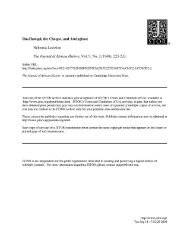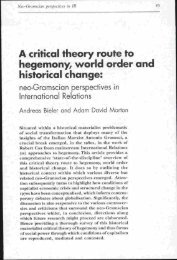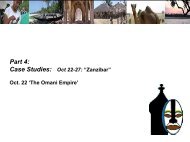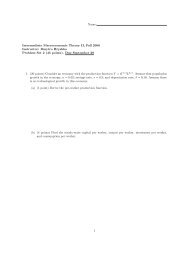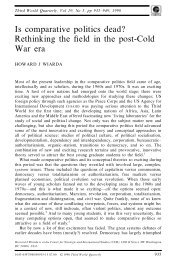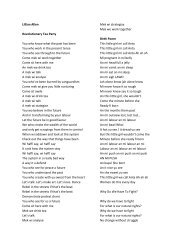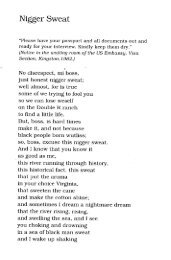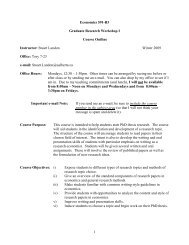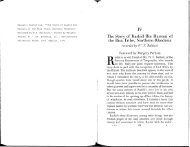personal memories revolutionary states and indian ocean migrations
personal memories revolutionary states and indian ocean migrations
personal memories revolutionary states and indian ocean migrations
You also want an ePaper? Increase the reach of your titles
YUMPU automatically turns print PDFs into web optimized ePapers that Google loves.
When Tippu Tip (properly Hamed bin Muhammad al-Murjebi) related his<br />
life as a trader <strong>and</strong> adventurer in eastern <strong>and</strong> central Africa in his autobiography, he<br />
recalled an incident from 1867 in which his porters warned him against advancing<br />
on Isamu’s territory in Urungu, southwest of Lake Tanganyika. They cautioned<br />
him to halt his advance because Isamu, though he had plentiful ivory, was cruel.<br />
They noted that he had already killed various Arabs, baysar, <strong>and</strong> coastal people. 33<br />
This hierarchy <strong>and</strong> grouping of people would have been one that a man of Omani<br />
descent such as Tippu Tip would have understood. Tippu Tip’s biographer, the<br />
German writer Heinrich Brode, a long-term resident of East Africa, described a<br />
baysar as an Arab from Oman who was not pure blooded but was descended from<br />
a slave caste. This marked them in contrast to “full-blooded” Arabs who were<br />
“Kubails,” i.e. qabā’il, tribesmen. 34 Whether or not the porters’ warnings<br />
represented their own conception <strong>and</strong> naming of various layers of Muslim society is<br />
an open question.<br />
In both Oman <strong>and</strong> East Africa, baysar faced social restrictions <strong>and</strong> Arabs<br />
expected them to conform to some behaviors of servants. Some places in Oman<br />
may have had substantial numbers of baysar inhabitants <strong>and</strong> little or no slave<br />
populations. 35 In Oman, baysar meeting a shaykh were not allowed to go directly to<br />
the man, kiss his h<strong>and</strong>s, <strong>and</strong> greet him. The expectations were that baysar, like<br />
slaves <strong>and</strong> other inferiors, would first drop their s<strong>and</strong>als at the side of the path. 36 In<br />
both Oman <strong>and</strong> East Africa, baysar were expected to defer to Arabs in social<br />
situations <strong>and</strong> greet Arabs of higher status, i.e. those with a tribal name, as<br />
“Hababi” (master). 37 Thus social proscriptions reified the status of baysar as a<br />
category in every day practice.<br />
The social restrictions extended, as the story of Zuwayna <strong>and</strong> Sulayman<br />
illustrates, to marriage. The prohibition of marriage between baysar men <strong>and</strong> Arab<br />
women was strong, <strong>and</strong> seemed to follow some aspects of the Islamic legal<br />
principle of kafā’a, or equality <strong>and</strong> sufficiency for marriage. In classical Islamic legal<br />
doctrine, kafā’a relates to the social status, fortune, <strong>and</strong> profession of the groom<br />
(vis-à-vis his father-in-law to be) <strong>and</strong> parity of birth of the couple. Kafā’a protects<br />
Muslim women from “inadequate” matches; Muslim men were permitted to marry<br />
women “below” them on a social—or economic—hierarchy. 38 A classical<br />
underst<strong>and</strong>ing of this would suggest differences of descent as part of parity of the<br />
couple, but such differences could be mitigated over time. A freed slave or Islamic<br />
convert was to be considered an equal to all Muslims after three generations. 39 It<br />
seems, however, that even though baysar were Muslim, they were subjected to more<br />
stringent social codes.<br />
Beyond these social restrictions, baysar seemed to enjoy some measure of<br />
freedom. In the 1920s a British traveler in southern Arabia noted that although the<br />
social position of a baysar was by definition subordinate, his societal roles <strong>and</strong><br />
occupation were not limited by his status. 40 In East Africa, Brode noted that<br />
despite their inferior social status with respect to the Arabs, baysar were “far<br />
superior to them in intelligence” <strong>and</strong> because of this were able to become quite<br />
wealthy <strong>and</strong> “raise their importance.” 41 This freedom to amass wealth <strong>and</strong> raise<br />
their status became important to baysar in East Africa. In a region where people<br />
from Oman were in the minority, the differentiations of status among Omanis<br />
became less important when the majority population was able to see both nonbaysar<br />
<strong>and</strong> baysar people from Oman as Arab.<br />
By the mid-twentieth century, the status of baysar in East Africa had<br />
changed. From the comfort of his home near Muscat, an Arab man born in<br />
Vol. 5, Fall 2005, © 2005 The MIT Electronic Journal of Middle East Studies<br />
38



